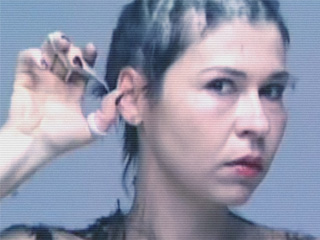Adriana Raggi
Throughout the history of art, humans have persistently looked at themselves, leading us all to perceive ourselves in an image that is repeated ad nauseam, yet is at the same time entirely essential. During earlier periods of art, whose productions are assumed to be of particular clarity, the self-portrait existed as a form enabling the artist to stand before others and declare who they were. Today, a complex process is taking place and we can therefore not call it self-portraiture, but seek other names, the most common being self-representation.
1.
Regardless of how we refer to it, a moment occurs in representation in which the artist carries out a performative act, in which he sees himself, which entails identification with the spectator. This action involves questioning the audience, the artist and the medium employed. One specific example is the key moment in Cris Birrenbach’s work Identidade, when he destroys himself before the camera, before us, to show us that gender and beauty can be referred to both playfully and violently, and that gender is merely a social construct achieved through performance. We act it out and repeat it, and in the same vein Birrenbach carries out an action before us which involves removing his gender and putting it on. He adopts it, discards it and then takes it up again. We are his mirror. We see him in this process of destruction, and feel strongly attracted to the image of a practice that we have undergone without realizing.
Identidade by Cris Bierrenbach
2.
On the other side of the mirror is Nicola Costantino, in her work Unfinished Rhapsody. In this video-installation presented at the Venice Biennial and embroiled in political controversy – when the Argentinian government wished to give it its own ending1 Argentina’s collective memory to bring us an intimate Evita, who is Eva and yet Nicola. In this work, self-representation is a form of self-destruction and reconstruction of the image of herself and of a historical icon of modern Argentina. It is a mise en scène, a performative construction of the artist’s body within Evita’s body. Costantino uses technology to reconstruct, through scenography and video, the history of the appliance that Eva allegedly used to support her sick body during her last public appearance. This was an Eva striving to maintain an image of strength. Meanwhile, Nicola’s body reveals a wound and a mystery.
Unfinished Rhapsody by Nicola Costantino
3.
The mystery of Eva is encapsulated in the work Meshes of the Afternoon by Maya Deren, in which the artist uses her image repeatedly, thus confronting us with episodes from our daily life and psyche and placing us in terrifyingly familiar spaces. Deren is pursuing a mysterious figure to find herself over and over again. The representations of Maya are ominous yet sumptuously beautiful. They remind us that we are only here for an instant.
Meshes of the Afternoon by Maya Deren
Final
When Guillermo Gómez Peña looks at us in his video performance To Death (Second duel), he says: “I have a surprise for you”, and from that moment onwards a mise en scène begins that enables us to understand the performance. Several questions remain unanswered. He puts on his body, as do Bierrenbach, Costantino and Deren. Here, his body is a self-representation but also a teaching tool. In his hands he holds a gun, the most powerful of tools. He aims it at us and shows us directly what all the other works have subtly demonstrated . A performative self-representation comments on the human being itself, and confronts us with what we are and are not. When we see Deren looking at herself, Bierrenbach destroying himself through violence, Costantino constructing herself in the body of another person, and finally, Gómez Peña aiming a gun at us, we realize that we are viewing out own finitude and fragility. What we are and do is determined by time, by the wound of knowing that we are going to die, the fragility of flesh and the absurd captivity of social limitations. At that moment, we can see each and every one of us.
To Death by Guillermo Gómez Peña
 Adriana Raggi (Mexico, 1970). Lives and works in Mexico. She has a Bachelor’s degree in Visual Arts at the National School of Plastic Arts and a Master’s degree and Doctorate in Art History at the Faculty of Philosophy and Literature, UNAM. She also followed the program Photo Narrative and New Media at the Pedro Meyer Foundation. She is professor at the National School of Plastic Arts and a member of the collective Las Disidentes. She has exhibited her work in Mexico and the United States, and also participated in more than twenty collective exhibitions. To see more of her work go to: www.adrianaraggi.net
Adriana Raggi (Mexico, 1970). Lives and works in Mexico. She has a Bachelor’s degree in Visual Arts at the National School of Plastic Arts and a Master’s degree and Doctorate in Art History at the Faculty of Philosophy and Literature, UNAM. She also followed the program Photo Narrative and New Media at the Pedro Meyer Foundation. She is professor at the National School of Plastic Arts and a member of the collective Las Disidentes. She has exhibited her work in Mexico and the United States, and also participated in more than twenty collective exhibitions. To see more of her work go to: www.adrianaraggi.net[core_state] => 1 [core_access] => 1 [core_metadata] => {"robots":"","author":"Adriana Raggi","rights":"","xreference":""} [core_created_user_id] => 841 [core_created_by_alias] => [core_created_time] => 2014-06-20 17:00:00 [core_images] => {"image_intro":"images\/categories\/liquididentity\/raggi.jpg","float_intro":"","image_intro_alt":"","image_intro_caption":"","image_fulltext":"images\/categories\/liquididentity\/raggi.jpg","float_fulltext":"","image_fulltext_alt":"","image_fulltext_caption":""} [core_modified_time] => 2015-09-30 17:48:39 [core_language] => en-GB [core_catid] => 47 [core_publish_up] => 2014-06-20 17:00:00 [core_publish_down] => 0000-00-00 00:00:00 [content_type_title] => Article [router] => ContentHelperRoute::getArticleRoute [author] => [author_email] => [link] => index.php?option=com_content&view=article&id=185:self-representation-and-mystery&catid=47&lang=en-GB [displayDate] => 2014-06-20 17:00:00 [event] => stdClass Object ( [afterDisplayTitle] => [beforeDisplayContent] => [afterDisplayContent] => ) [text] =>
Throughout the history of art, humans have persistently looked at themselves, leading us all to perceive ourselves in an image that is repeated ad nauseam, yet is at the same time entirely essential. During earlier periods of art, whose productions are assumed to be of particular clarity, the self-portrait existed as a form enabling the artist to stand before others and declare who they were. Today, a complex process is taking place and we can therefore not call it self-portraiture, but seek other names, the most common being self-representation.
1.
Regardless of how we refer to it, a moment occurs in representation in which the artist carries out a performative act, in which he sees himself, which entails identification with the spectator. This action involves questioning the audience, the artist and the medium employed. One specific example is the key moment in Cris Birrenbach’s work Identidade, when he destroys himself before the camera, before us, to show us that gender and beauty can be referred to both playfully and violently, and that gender is merely a social construct achieved through performance. We act it out and repeat it, and in the same vein Birrenbach carries out an action before us which involves removing his gender and putting it on. He adopts it, discards it and then takes it up again. We are his mirror. We see him in this process of destruction, and feel strongly attracted to the image of a practice that we have undergone without realizing.
Identidade by Cris Bierrenbach
2.
On the other side of the mirror is Nicola Costantino, in her work Unfinished Rhapsody. In this video-installation presented at the Venice Biennial and embroiled in political controversy – when the Argentinian government wished to give it its own ending1 Argentina’s collective memory to bring us an intimate Evita, who is Eva and yet Nicola. In this work, self-representation is a form of self-destruction and reconstruction of the image of herself and of a historical icon of modern Argentina. It is a mise en scène, a performative construction of the artist’s body within Evita’s body. Costantino uses technology to reconstruct, through scenography and video, the history of the appliance that Eva allegedly used to support her sick body during her last public appearance. This was an Eva striving to maintain an image of strength. Meanwhile, Nicola’s body reveals a wound and a mystery.
Unfinished Rhapsody by Nicola Costantino
3.
The mystery of Eva is encapsulated in the work Meshes of the Afternoon by Maya Deren, in which the artist uses her image repeatedly, thus confronting us with episodes from our daily life and psyche and placing us in terrifyingly familiar spaces. Deren is pursuing a mysterious figure to find herself over and over again. The representations of Maya are ominous yet sumptuously beautiful. They remind us that we are only here for an instant.
Meshes of the Afternoon by Maya Deren
Final
When Guillermo Gómez Peña looks at us in his video performance To Death (Second duel), he says: “I have a surprise for you”, and from that moment onwards a mise en scène begins that enables us to understand the performance. Several questions remain unanswered. He puts on his body, as do Bierrenbach, Costantino and Deren. Here, his body is a self-representation but also a teaching tool. In his hands he holds a gun, the most powerful of tools. He aims it at us and shows us directly what all the other works have subtly demonstrated . A performative self-representation comments on the human being itself, and confronts us with what we are and are not. When we see Deren looking at herself, Bierrenbach destroying himself through violence, Costantino constructing herself in the body of another person, and finally, Gómez Peña aiming a gun at us, we realize that we are viewing out own finitude and fragility. What we are and do is determined by time, by the wound of knowing that we are going to die, the fragility of flesh and the absurd captivity of social limitations. At that moment, we can see each and every one of us.
To Death by Guillermo Gómez Peña
 Adriana Raggi (Mexico, 1970). Lives and works in Mexico. She has a Bachelor’s degree in Visual Arts at the National School of Plastic Arts and a Master’s degree and Doctorate in Art History at the Faculty of Philosophy and Literature, UNAM. She also followed the program Photo Narrative and New Media at the Pedro Meyer Foundation. She is professor at the National School of Plastic Arts and a member of the collective Las Disidentes. She has exhibited her work in Mexico and the United States, and also participated in more than twenty collective exhibitions. To see more of her work go to: www.adrianaraggi.net
Adriana Raggi (Mexico, 1970). Lives and works in Mexico. She has a Bachelor’s degree in Visual Arts at the National School of Plastic Arts and a Master’s degree and Doctorate in Art History at the Faculty of Philosophy and Literature, UNAM. She also followed the program Photo Narrative and New Media at the Pedro Meyer Foundation. She is professor at the National School of Plastic Arts and a member of the collective Las Disidentes. She has exhibited her work in Mexico and the United States, and also participated in more than twenty collective exhibitions. To see more of her work go to: www.adrianaraggi.net[id] => 185 [language] => en-GB [catid] => 47 [jcfields] => Array ( ) ) 1

